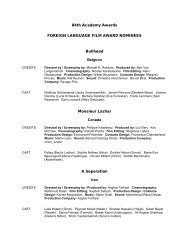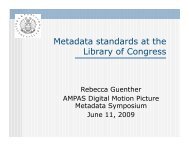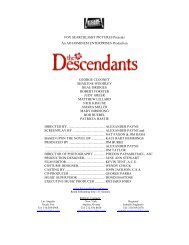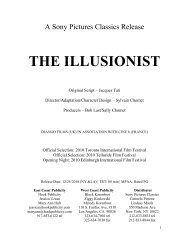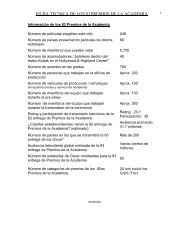Download Report - Academy of Motion Picture Arts and Sciences
Download Report - Academy of Motion Picture Arts and Sciences
Download Report - Academy of Motion Picture Arts and Sciences
You also want an ePaper? Increase the reach of your titles
YUMPU automatically turns print PDFs into web optimized ePapers that Google loves.
divided into three equal portions representing approximately<br />
the three primary colors: blue, green,<br />
<strong>and</strong> red. -ih. dirtitional points are indicated by the<br />
wave-length scale at the bottom <strong>of</strong> the figure. It<br />
is assumed that this spectrum represents that <strong>of</strong><br />
rvhite light, for instance light from the noonday<br />
sun. In the spectrum designated as ..4 absorption <strong>of</strong><br />
blue is indicated by the shaded area' The remaining<br />
light consists <strong>of</strong> red <strong>and</strong> green which added tog"ther<br />
give a yellow color. Thus the absorption <strong>of</strong><br />
6lue reiults in yellow. Complementary colors are<br />
those which when added together result in white.<br />
complementary to each other. Since the absorption<br />
<strong>of</strong> blue results in yellow, the converse must be true<br />
that the absorption <strong>of</strong> yellow, that is the red <strong>and</strong><br />
'<br />
FIGURE<br />
Diagram illustrating selective absorption <strong>of</strong> narrow<br />
spectral b<strong>and</strong>s.<br />
green components <strong>of</strong> white light, will give blue. In<br />
the spectrum designated as B green has been absorbed.<br />
The remaining radiation consists <strong>of</strong> red<br />
<strong>and</strong> blue which, when mixed together, produce<br />
magenta ( minus-green ) . In the spectrum designated<br />
as C the shaded area indicates that red has<br />
been absorbed leaving blue-green. Conversely, if<br />
the blue <strong>and</strong> green be absorbed, red will be obtained.<br />
The absorption b<strong>and</strong>s illustrated in Fig.9 by the<br />
shaded areas represent hypothetical conditions which<br />
are never found to exist in natural objects. Instead,<br />
the selective absorption found in actual practice<br />
occurs in b<strong>and</strong>s such as are illustrated in Fig. 10.<br />
In the upper part <strong>of</strong> the figure at ,4 the portion<br />
shaded by the diagonal line sloping to the right<br />
represents an ideal absorption b<strong>and</strong> such as can be<br />
realized only in an optical instrument. The removal<br />
<strong>of</strong> the radiation represented by this shaded area,<br />
IX<br />
which includes the yellow <strong>and</strong> orange, leaves violet.<br />
The area under the curve shaded by lines sloping to<br />
the left illustrates the absorption b<strong>and</strong> o{ dye giving<br />
a violet color. At B in Fig.70 the two areas shaded<br />
by lines sloping to the right illustrate the production<br />
oi a blue-gi.en color by the sharp-cut absorption <strong>of</strong><br />
the extreme violet <strong>and</strong> the red <strong>and</strong> orange spectral<br />
reEions, The area under the curve shaded by lines<br />
sloping to the left shows the spectral absorption <strong>of</strong><br />
u Jy. giuit g a corresponding blue-green color. The<br />
faci that piactically all colored objects which are<br />
photographed have absorption b<strong>and</strong>s which are not<br />
ubr,rpi but <strong>of</strong> the gradually cutting type, makes it<br />
possitl" to obtain, in general, much better tonal<br />
rendition than if natural colors were produced by<br />
absorption b<strong>and</strong>s <strong>of</strong> the abrupt type.<br />
Color in non-luminous objects, there{ore, may be<br />
considered as being due to selective absorption <strong>of</strong><br />
the luminous radiation incident thereon. This selective<br />
absorption is best expressed quantitatively in<br />
te rms <strong>of</strong> spectrophotometric curves which show<br />
reflecting power as a {unction o{ wave-length. The<br />
curves in Fig. 10 are typical <strong>of</strong> such spectrophotometric<br />
reflection curttes' Practically all pigments<br />
<strong>and</strong> dyes have absorption characteristics <strong>of</strong> the<br />
general type illustrated in Fig.10, although in some<br />
Jases the ibsorption either at one or both sides <strong>of</strong><br />
the b<strong>and</strong> may be somewhat sharper than shown.<br />
Quantitative data relative to the spectral character-<br />
trulE<br />
lEN67u<br />
FIGURE<br />
Spectral reflection curves <strong>of</strong> various pig:ments'<br />
XI<br />
FIGURE<br />
Diagram illustrating the difierence between<br />
Practical selective absorption'<br />
X<br />
theoretical<br />
<strong>and</strong><br />
t34l<br />
istics <strong>of</strong> a few colored materials are shown in Figs'<br />
11 <strong>and</strong> 12. These are taken from a publication by<br />
M. Luckeisht who also gives a large amount o{ data<br />
relative to the colored materials such as dyes, inks,<br />
etc. An examination <strong>of</strong> the curves in Figs. 11 <strong>and</strong><br />
72 reveals some rather interesting features. The<br />
materials represented by these curves may be taken<br />
as representative in a general way <strong>of</strong> the coloring<br />
mateiials available for producing color in paints,<br />
fabrics, wall papers, etc. It will be noted that the<br />
curves for r.J, orange) <strong>and</strong> yellow pigments have<br />
high refle-tion factors in the spectral<br />
lelartivelv<br />
1. Luckeish, M. The Physical Basis, <strong>of</strong> Color<br />
i..hnology. J. Frank. Inst', Julv, 1917' p' 86'





